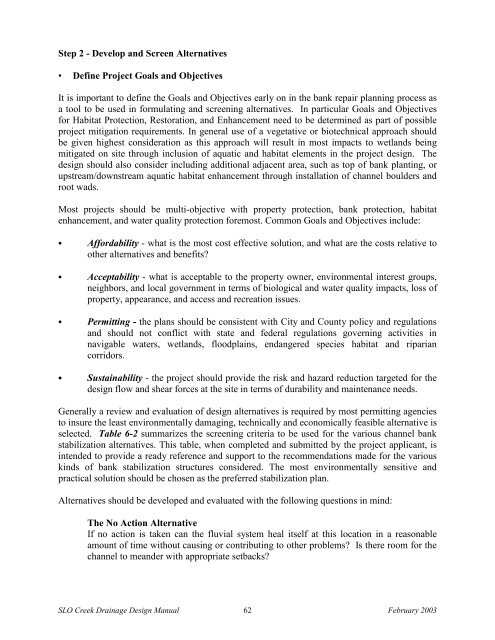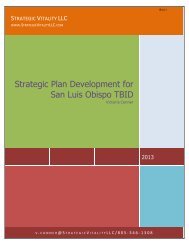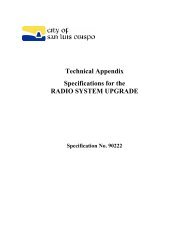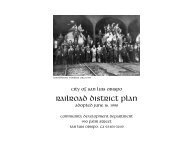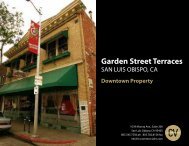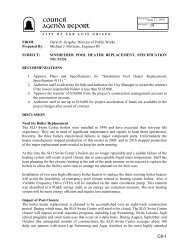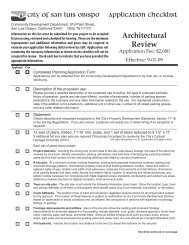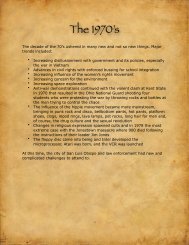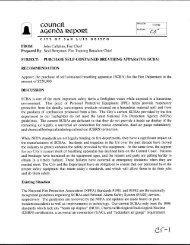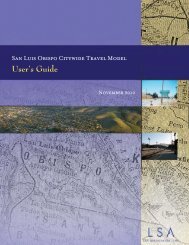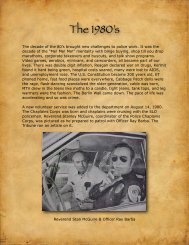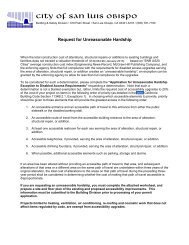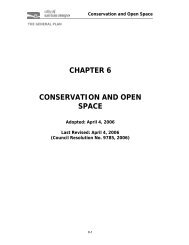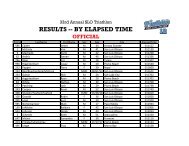Drainage Design Manual - the City of San Luis Obispo
Drainage Design Manual - the City of San Luis Obispo
Drainage Design Manual - the City of San Luis Obispo
Create successful ePaper yourself
Turn your PDF publications into a flip-book with our unique Google optimized e-Paper software.
Step 2 - Develop and Screen Alternatives• Define Project Goals and ObjectivesIt is important to define <strong>the</strong> Goals and Objectives early on in <strong>the</strong> bank repair planning process asa tool to be used in formulating and screening alternatives. In particular Goals and Objectivesfor Habitat Protection, Restoration, and Enhancement need to be determined as part <strong>of</strong> possibleproject mitigation requirements. In general use <strong>of</strong> a vegetative or biotechnical approach shouldbe given highest consideration as this approach will result in most impacts to wetlands beingmitigated on site through inclusion <strong>of</strong> aquatic and habitat elements in <strong>the</strong> project design. Thedesign should also consider including additional adjacent area, such as top <strong>of</strong> bank planting, orupstream/downstream aquatic habitat enhancement through installation <strong>of</strong> channel boulders androot wads.Most projects should be multi-objective with property protection, bank protection, habitatenhancement, and water quality protection foremost. Common Goals and Objectives include:Affordability - what is <strong>the</strong> most cost effective solution, and what are <strong>the</strong> costs relative too<strong>the</strong>r alternatives and benefits?Acceptability - what is acceptable to <strong>the</strong> property owner, environmental interest groups,neighbors, and local government in terms <strong>of</strong> biological and water quality impacts, loss <strong>of</strong>property, appearance, and access and recreation issues.Permitting - <strong>the</strong> plans should be consistent with <strong>City</strong> and County policy and regulationsand should not conflict with state and federal regulations governing activities innavigable waters, wetlands, floodplains, endangered species habitat and ripariancorridors.Sustainability - <strong>the</strong> project should provide <strong>the</strong> risk and hazard reduction targeted for <strong>the</strong>design flow and shear forces at <strong>the</strong> site in terms <strong>of</strong> durability and maintenance needs.Generally a review and evaluation <strong>of</strong> design alternatives is required by most permitting agenciesto insure <strong>the</strong> least environmentally damaging, technically and economically feasible alternative isselected. Table 6-2 summarizes <strong>the</strong> screening criteria to be used for <strong>the</strong> various channel bankstabilization alternatives. This table, when completed and submitted by <strong>the</strong> project applicant, isintended to provide a ready reference and support to <strong>the</strong> recommendations made for <strong>the</strong> variouskinds <strong>of</strong> bank stabilization structures considered. The most environmentally sensitive andpractical solution should be chosen as <strong>the</strong> preferred stabilization plan.Alternatives should be developed and evaluated with <strong>the</strong> following questions in mind:The No Action AlternativeIf no action is taken can <strong>the</strong> fluvial system heal itself at this location in a reasonableamount <strong>of</strong> time without causing or contributing to o<strong>the</strong>r problems? Is <strong>the</strong>re room for <strong>the</strong>channel to meander with appropriate setbacks?SLO Creek <strong>Drainage</strong> <strong>Design</strong> <strong>Manual</strong> 62 February 2003


